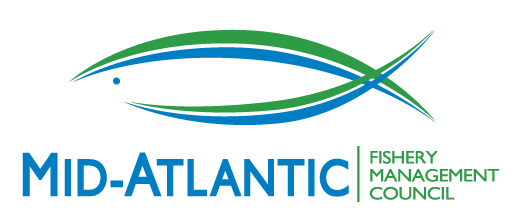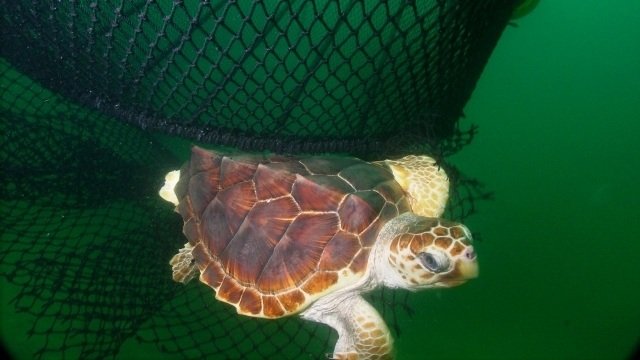Protected Resources
During the development of fishery management plans and amendments, the Council is required to evaluate potential interactions of the managed species with non-target species, endangered species, and marine mammals. The Council coordinates its management plans with the NMFS Greater Atlantic Regional Office to address and mitigate any potential interactions.
The two protected resource laws that the Council most frequently considers in its decision-making are the Marine Mammal Protection Act and the Endangered Species Act.
Right whale mother and calf, sighted June 8, 2014, during survey. Credit: NOAA.
Marine Mammal Protection Act
The Marine Mammal Protection Act (MMPA) of 1972 was enacted to maintain marine mammal stocks at their optimum sustainable population level and to restore depleted stocks. The law prohibits the take of all 128 species of marine mammals, including whales, dolphins, sea otters, manatees, polar bears, seals, and walruses. The term “take” is defined as “to harass, hunt, capture, or kill, or attempt to harass, hunt, capture or kill any marine mammal.”
Marine mammals interact with various U.S. commercial fisheries. The MMPA requires NOAA Fisheries to publish an annual List of Fisheries and classify each fishery based on whether it has frequent (Category I), occasional (Category II), or remote likelihood (Category III) of incidental mortality and serious injury of marine mammals.
For certain marine mammals that interact with Category I and II fisheries, the MMPA requires NMFS to develop and implement Take Reduction Plans to minimize bycatch and support recovery efforts. To develop these plans, NMFS convenes Take Reduction Teams (TRTs) composed of representatives from the fishing industry, fishery management councils, state and federal resource management agencies, the scientific community, and conservation organizations. The Mid-Atlantic Council participates in several such teams, including the Atlantic Large Whale, Atlantic Pelagic Longline, and Harbor Porpoise TRTs.
Loggerhead turtle escaping a net equipped with turtle excluder device (TED). Credit: NOAA.
Endangered Species Act
The Endangered Species Act of 1973 provides for the conservation of threatened and endangered plants and animals. It also calls for protection of the habitats and ecosystems in which these species are found. The law requires federal agencies, in consultation with the U.S. Fish and Wildlife Service (USFWS) and/or the NMFS, to ensure that the actions they authorize are not likely to jeopardize the continued existence of any endangered species or cause the destruction of the habitats those species depend on.
Atlantic sturgeon swimming. Credit: NOAA Fisheries.
NMFS documents its evaluations through Biological Opinions, which analyze how an action affects ESA-listed species and designated critical habitat. These analyses can inform the Council’s management decisions and help guide mitigation strategies. For example, in 2017 NMFS reinitiated consultation on the authorization of several federal fisheries in light of new information on the status of North Atlantic right whales. The resulting 2021 Biological Opinion assessed the impacts of these fisheries on multiple ESA-listed species, including Atlantic sturgeon. The opinion required NMFS to develop an Action Plan to reduce Atlantic sturgeon bycatch in federal large mesh gillnet fisheries by 2024. Based on recommendations in the Action Plan, the Mid-Atlantic and New England Fishery Management Councils developed and approved a joint action to reduce Atlantic sturgeon bycatch in the monkfish and spiny dogfish gillnet fisheries.



